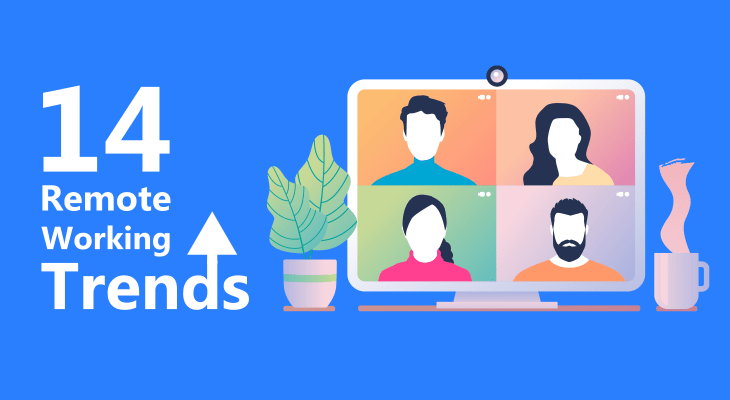14 Remote Working Trends for 2020

While working from home is not a new concept, and it has been gaining popularity in the past years, numerous companies and businesses are still reluctant and unprepared for such a change.
However, with the outbreak of COVID-19 and the people worldwide being under lockdown, the need for adapting to remote work has dramatically increased and it has profoundly impacted our professional and personal lives. Many companies and businesses have been forced to shift to a remote work model and find solutions for the inability of people to come to the workplace in order to keep up with the incredible financial strain the unfortunate situation has imposed.
As the world is actively looking for the safest way to open up communities and businesses and return to the ‘normal’ state or to how things were previously, we have to admit to ourselves that it will take a rather long while, and most likely it won’t be exactly the same.
What’s certain is that remote work is here to stay. Companies, especially those in the tech-industry, are starting to realize the benefits of embracing flexible workplace policies. And employees seem to be enjoying the new work from home trends and benefits which boost their productivity. Lots are even considering working remotely on a permanent basis.
This year, many new trends along with the increased visibility of the benefits of remote working have emerged. While studies and surveys are indicating that remote working leads to increased productivity and higher employee retention, the reduced environmental impact was absolutely evident. The pandemic has turned out to be a crash course on remote working where companies have deployed technologies, developed policies, tested for the best practices, and have also broken down some taboos to pave the way of a long term change. And many people seem to be changing their living arrangements and locations.
So, here are some remote working trends that have marked this year.
- Reliance on Technology
- Rise of Security Concerns
- Business and Talent shift
- Improved Diversity and Inclusion in Teams
- Establishing Human Connection through Video
- Embracing a More Flexible Work Schedule
- Increased Demand for Work from Home Options
- Increased Opportunities for Work from Home
- A Rise of Co-working Spaces
- A Rise of Remote Content Creators
- Jumpstart for Start-ups
- Rise of mental health issues among remote workers
- Transformation of Offices
- Reducing Environmental Impact
1. Heavy Reliance on Technology and New Apps as Workplace Tools.

The lockdown has forced us to turn to any available app for working and maintaining social connections, and has increased our awareness of the necessity and importance of supporting technologies. Experts predict that more and more software will be developed to cater for some specific needs, such as stay-at-home applications for exercise, learning, and work.
While collaborative apps like Slack, Zoom, and Google Suites had been around for a while to assist with the virtual connections, with the pandemic, they have become the everyday tools for the remote workforce around the world. So, with the worldwide constant use of such platforms, we can expect them to become even more secure and user-friendly.
Additionally, more and more companies will turn towards the cloud as a practical solution and they will also require remote monitoring platforms and predictive maintenance tools.
2. A Rise of Security Concerns.

With the increased reliance on technology, the risk of inadequate IT security is apparent.
Remote work will most certainly expose new threats, so companies will need to be careful with taking care of cyber security. Soon enough, we are certain to expect many new and enhanced individual, businesses, and network cyber security products.
3. Business and Talent shift.

Apart from the technology, the remote work requires and allows for many other changes. With the pandemic, we have collectively realized that relationships are crucial for the enterprise and its productivity, and not the actual controlled environment in an office. Trust and goodwill between employees and businesses is paramount.
Our shared experience will contribute for a better comprehension of both the limitations and perks of distributed work. Along with the cultural shifts, we will soon begin to notice a shift from emphasis on talent over location as the talent pool of remote workers is vast.
4. Improved Diversity and Inclusion in Teams.

In line with the talent shift is the trend of improved diversity and inclusion in teams. As people are working from home, companies have the opportunity to hire talents regardless of their location, gender and ethnicity. COVID 19 seems to serve as a catalyst for reducing the concern for the physical constraints of locations.
The flexible workplace policies will also provide many new opportunities to applicants that are usually not considered by companies due to some disability.
5. Establishing Human Connection through Video.

Even though we cannot replace the actual in-person collaboration, a lot of progress has been made to decrease the pain points, to help increase the human connection and even make work more fun.
With the companies adapting to full-time remote work, an emerging trend that can be noted are the virtual town halls that leaders use to connect the employees. Large conferences as well as events are held online.
More and more people use the option to record the meetings, same as teachers record the lessons for absent students, to help their colleagues that are unable to attend.
6. Embracing a More Flexible Work Schedule.

Employees are productive under different circumstances. What suits one person, doesn’t work the same for another.
The remote work has allowed for a more flexible workday, which in turn provides people with the opportunity to work at a time they are most productive.
This trend has enabled people to break up the day in a way that is best for their personal productivity and gives them space for dealing with responsibilities outside of work.
7. Increased Demand for Work from Home Options.

Being forced to adapt to remote working has actually made people realize the number of benefits it provides.
Employees save plenty of time and money by not commuting; they save on clothes and laundry from not dressing up, or money from not eating out.
People that telecommute arrive to work simply by waking up and getting to work on their desks (or even staying in their own bed) which removes the morning hassle and stress to arrive at the office on time.
Apart from the financial incentives, working from home brings other personal and wellness benefits.
People are now able to spend more time with their families at home. They can start eating healthier as they have more time and opportunities for cooking. And there is even time for exercise.
8. Increased Opportunities for Work from Home.

A certain outcome of this year’s situation is the bigger number of working from home arrangements.
As companies have managed to save overhead costs from cutbacks in travel, office space and perks by adopting flexible workplace arrangements, they will continue to create opportunities for their employees to be able to work from home.
While there certainly are jobs that can only be done on-site, there will be opportunities for some to shift at least part of the time to be from home.
9. A Rise of Co-working Spaces.

This trend has been on the rise for the past few years and it will stay that way.
There are more and more co-working spaces established to cater to remote workers’ needs.
There are even some co-working spaces that are specialized to certain niches in the industry. Many new facilities and activities that not only provide comfort but also wellness for the remote workers are appearing.
Although the situation with COVID 19 has temporarily put a halt on attending such spaces, the trend is certain to remain.
10. A Rise of Remote Content Creators.

People around the world consume internet content daily, whether for entertainment, learning or informative purposes, and especially during the quarantine.
More and more brands use content marketing strategies for getting more visibility and engagement online.
This increases the need of more and more content creators that can effectively strategize and manage content. Most, if not all, tasks performed by these professionals can be done from their own homes.
So, the content creators will soon enough dominate the industry share of remote work.
11. Jumpstart for Start-ups.

Remote work has proven as an excellent starting point for new businesses and has encouraged many remote professionals to become business owners.
Perhaps, the most obvious example is this site, GorillaPDF.
With the online job marketplaces, start-ups are able to save on overhead and salary costs. The professionals and freelancers found on such platforms offer considerably lower rates than those who have to commute and come in for work. Also, start-ups are able to outsource their worries about legal and payment processing services to the online platforms.
Most importantly, the remote professionals working through such platforms are in time able to expand their one-person operation into teams of people that will provide the same service on a large scale.
12. Rise of mental health issues among remote workers.

Not as much of a trend but rather a concern are the wellness-related issues of telecommuters.
While remote work can sound like the best arrangement ever, it is important to note that anxiety and depression are reported much more among remote employees than their colleagues in the office.
Mental health issues quickly manifest with insomnia and lack of focus, which can considerably affect the performance of the remote employee.
13. Transformation of Offices.

While the physical working spaces will not be obliterated any time soon, they are starting to be adapted and transformed to fit the new safety standards.
Companies are required to redesign their offices to comply with the safety regulations in place. Moreover, looking into the future, each company will search for the best balance between office and remote work culture.
Many offices will most likely be less and less used for working and will serve for important meetings and gatherings.
14. Reducing Environmental Impact.

A thing that mustn’t be overlooked in the remote working trends is the increased awareness of the environmental impact we can have.
With the recent global lockdown, we have witnessed the everyday effect on environment we have. Having the chance to work from home, even partially, will help save the environment as the pollution caused by commuting will be drastically reduced.
Also, we can save billions of kilowatt-hours of energy each year by using electronic devices to work from home.
Final Thoughts
Summed up, we can be sure that many adaptations and transformations are in store for remote work, and technology has the crucial role in the future of collaboration.
We should note that while human connection and interaction seem simple, they are very easy to overlook.
How has your workplace been affected and what are the novelties that have emerged for you this year?
